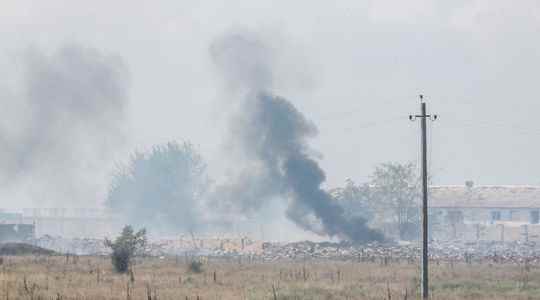A nightmarish night for the Russian defense. And perhaps a turning point in the war. Bad news followed on the night of August 18 to 19 for the Moscow headquarters: a series of explosions on its soil, in the province of Belgorod, less than 50 kilometers from the Ukrainian border; strikes on the Belbek air base in Crimea, near the Russian fleet headquarters in Sevastopol; others in the north of the same province – annexed in 2014 by Russia -, towards Mezhvodny.
In the aftermath, “panic gripped the Russian forces in Crimea, whose anti-aircraft defenses were triggered above the naval base of Sevastopol and around the Kerch Strait and its precious bridge”, says the military historian Cedric Mas on Twitter. The structure, which connects the peninsula to mainland Russia, is one of the most strategic: the materials and equipment necessary for the Russian forces pass through it.
In recent days, the Ukrainian army has increased the pressure on the rear bases in Moscow. “At first, they started by hitting shell depots, explains former colonel of the navy troops Michel Goya. Because the main strength of the Russian army is its artillery, and the nerve of the artillery, these are the shells, tens of thousands of them have to be brought to the front every day, which arrive by rail, are delivered to depots and then taken to battle by trucks that go back and forth.
Kyiv’s goal? Disrupt these supplies as much as possible and dry up the enemy’s reserves to support a counter-offensive in the south, of which the recent strikes in Crimea and in the Melitopol region, under Russian occupation, are perhaps heralds. The Ukrainians want at all costs to prevent the front line from freezing. The stakes are political as much as military: to stimulate the support of Western partners, President Volodymyr Zelensky has every interest in showing that his forces continue to make breakthroughs.
Targeting operations on Russian rear bases began in early summer. Between the end of June and the first week of July, about ten shell depots were targeted. A strategy of “assault breaker”, inspired by that of NATO in the 1970s, deciphered at the time on Twitter the analyst Ulrich Bounat. It takes place “in two stages, he writes: resist the first wave, and prevent the second from arriving” thanks to targeted strikes preventing the Russians from bringing their weapons to the front.
“A Corsair War”
This rear battle is made possible thanks to Western deliveries of high-performance artillery means. The Ukrainian army thus has Himars multiple rocket launchers, delivered by the United States. “You draw a circle 5 meters in diameter within a radius of 80 kilometers: one out of two rockets will fall in this circle, it’s extraordinarily precise”, adds Michel Goya. Even more powerful is the M270 model, capable of firing 12 surface-to-surface missiles in one minute, twice as many as the Himars system.
“There are two types of operation in a war, continues the retired colonel: conquest, where we try to plant flags on the ground on which we are advancing. And pressure operations, where we multiplies the blows. There, the goal is not to seize the ground but to hit in the hope, in the long term, of a strategic effect, a collapse or a capitulation. This is what happened in the battle of Serpents’ Island: The Ukrainians harassed all Russian positions on the island, carried out drone raids, airstrikes, then strikes, until the Russians cracked. what kyiv hopes for in the pocket of Kherson.”
This is the face that the Ukrainian “counter-offensive” will certainly take: no flash breakthrough, improbable given the wear and tear on the troops and the reduction in available resources, but a series of targeted strikes. “The second level actions tend to become the main combat, on both sides, Russian and Ukrainian”, continues Michel Goya, for whom the conflict is entering a new phase: a “war of corsairs”, according to an expression inherited from the war from Indochina. In other words: strike the enemy in a punctual way by daring raids.
